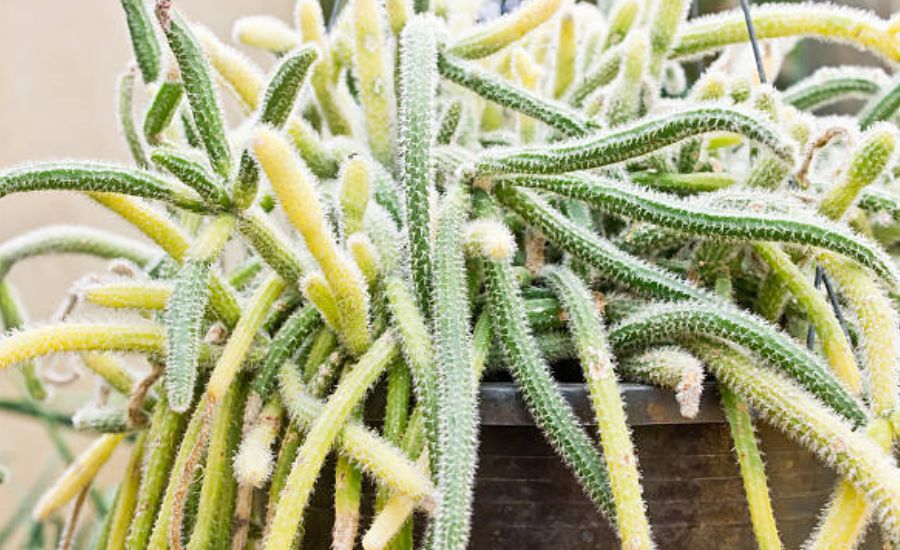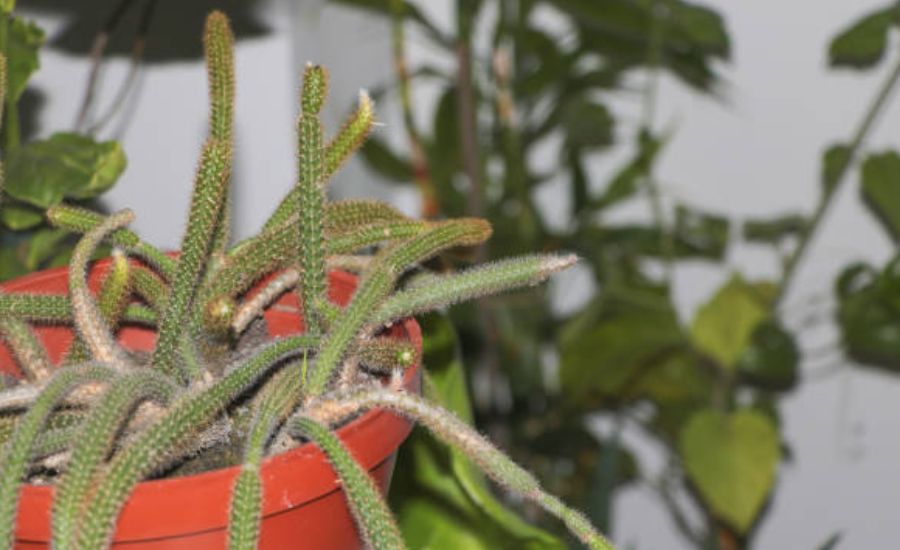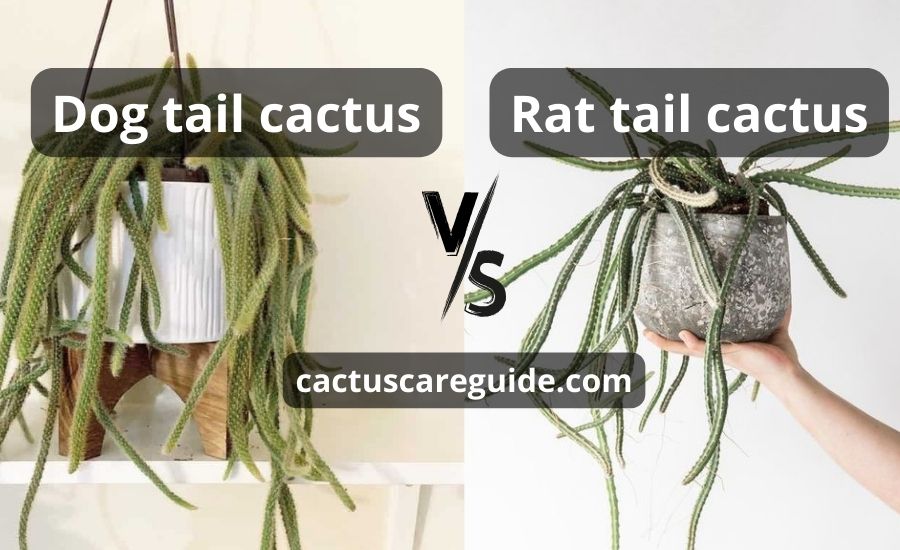Dog Tail Cactus vs. Rat Tail Cactus: Revealing Them
When buying cacti for your house, garden, or greenhouse, there are often disputes about which is the appropriate choice: dog tail cactus vs. rat tail cactus. This review will provide basic information about these cacti: what are their differences, what are typical, and flourishing conditions.

General info
Cacti are one of the most beloved indoor plants; they are valued for their ease of maintenance, as well as for their variety of species and shapes. In this part, we will compare the facts of dog-tail cactus and rat-tail cactus.

Dog tail cactus vs. rat tail cactus: taxonomy
Scientists place the dog tail cactus in the genus of succulent cacti, namely the Disocactus genus and it is scientifically known as Straphocactus Testudo. These types of plants are classified as epiphytic cacti.
This means that in nature, it grows on other plants. Hence the unusual trailing stems of this cactus, indicate that this cactus likes to hang down and wrap around the support on which it grows.
Scientists classify the Rat Tail cactus as a cactus succulent, typically a perennial succulent.
Biologists named it Aporocactus flagelliformis. This type of cactus is also an epiphytic and is the most cultivated in the Aporacactus genus.
Hence we see that both are succulents and epiphytic types, but the genus is different.

Dog tail cactus vs. rat tail cactus: genesis
Dog tail cactus genesis is not well defined. Native habitat covers countries such as Mexico, Costa Rica, and Venezuela (South America). It exists as an epiphytic plant in tropical rainforests.
Epiphytic plant gains access to more sunlight by thriving on other plants, especially on larger trees.
Rat tail cactus usually flourish in the wild within the regions of Guatemala, Belize, and southern Mexico. Places where they naturally thrive include different landscapes such as tropical rainforests and dry scrublands.

Dog tail cactus vs. rat tail cactus: traits
The traits are very similar to one another. Read the following to compare.
Dog tail cactus
The stems trailing and segmented. Their length varies from 9 to 10 ft. Their length and shape make them suited to hanging baskets or raised flower pots.
Typically, dog-tail is best suited for 7-11 USDA hardiness. These locations correspond to areas with relatively mild winters and warm temperatures year-round.
It can thrive in warm climates and tolerate temperatures ranging from 39-80 °F throughout the growing period.
In addition, dog tail cactus is acclimated to thriving in conditions with comparatively higher humidity. Generally, a humidity level of around 50% is enough for this indoor plant.

Rat tail cactus
The main feature of the rat tail cactus is long stem rods extending 6-9 feet. These stems look like jellyfish tentacles, covered in miniature spines.
This cactus exists in subtropical conditions in nature, being best suited for 9-11 USDA zones. In these areas, rat tail cactus can flourish as a garden plant.
Rat tail cacti also appreciate warm conditions. It can tolerate temperatures in intervals of 40-90 °F.
For rat tail cactus 50% humid air would be enough, as for dog tail cactus. It can adapt to average inside humid air.

Dog tail cactus vs. rat tail cactus: bloom
Inherently, spring and summer months are seasons of flowering plants. Dog tail cactus flowers are pristine white. Simultaneously, these flowers bloom at night, which indicates that these cacti are nocturnal bloomers.
It might happen that these cacti will not bloom at all. If the factors are not optimal, the cactus will not bloom beautifully.
Late spring and early summer months are seasons when rat tail cactus shows its beautiful flowers. These lovely blooms appear on its trailing stems. Rat tail cactus mainly gives orange or pink flowers. Hence, both plants can bloom, but their colors are different.

Growing conditions
If you decide to bring and propagate dog tail cactus inside the house and help it to develop roots, you must consider multiple conditions: soil in which they’re growing, sunlight exposure, etc. This also applies to rat-tail cactus.
Dog tail cactus vs. rat tail cactus: proper soil
- Put dog tail cactus in well-draining soil as part of the cactus mix. You can make potting mixes from well-draining soil and organic materials. The pH indicator of soil can vary from neutral pH to slightly acidic values.
- Rat tail cactus necessitates a cacti potting mix made of fast-draining soil mixed with well-draining organic materials like peat moss or coconut coir.

Dog tail cactus vs. rat tail cactus: solar exposure
- Dog tail enjoys the bright partial sun with indirect light. If you put it in optimal sunlight conditions, it will produce the usual sharp spines. In case of shortage of sufficient sunlight, its green spiny stems fade and its spines become smooth. So, you must stick to the optimal bright sunlight.
- Rat tail thrives best in bright, direct sun similar to desert conditions. It is possible to place rat-tailed cactus outside. However, you must consider an optimal interval of temperature to avoid plant freezing.

Dog tail cactus vs. rat tail cactus: water requirements
Ordinarily, rat tail cactus demands much less moisture than dog tail cactus, since it is inherently a more drought-tolerant plant.
- Water dog-tale cactus often during the period of growing. Also, you should let the soil dry between watering. With abundant moisture and frequent watering, root rot may occur. So, need a balance when you hydrate its soil.
- Sprinkle rat-tail cactus thoroughly when the soil is dry; avoid overwatering to prevent root rot. It is drought tolerant, which is a characteristic of the rat tail cactus. No watering is required during the winter months.
Recommended: Bottom Watering Cactus

Dog tail cactus vs. rat tail cactus: adding fertilizer
- Fertilize dog tail cactus poorly within the period of growing with an optimal cactus fertilizer.
- Apply diluted fertilizer in spring and summer, avoid winter fertilizing. Rat Tail Cactus just thanks you for this treatment.
Propagate succulents: method
Both can be propagated using cuttings from the stem. Here is how to do it.
- Flowering plant lovers usually use stems (not seeds) to make more dog-tail cacti. Cut off a robust stem accurately. Allow the severed stem to rest on a paper towel for a few hours. Then place it in a basket with soil.
- Making more rat-tail cacti is pretty much the same as making more dog-tail cacti. Just make sure you choose a vibrant stem and trim 2 inches of it. The next steps are identical.

Dog tail cactus vs rat tail cactus: similarity
Let’s see what these two cacti have in common.
- fun fact: both remind us of animals;
- both of these cacti are inherently epiphytic air plants, not traditional terrestrial plants;
- grow indoors and like warm places;
- they do not tolerate frost;
- both are fans of bright lights.

Dog tail cactus vs. rat tail cactus: home placement
Dog tail cactus is a fine option for your homeplace. Plant lovers like to grow it in windows so it gets enough sunlight. It’s often grown with other cacti in special boxes or even in gardens.
Rat tail cactus is also a houseplant. It favors warm places, so it’s great outside if it’s not too cold.
People often hang it, especially in hanging baskets, in gardens with little water, or just keep it in a pot.
The hanging basket should be a good choice for dog tail cactus too.
Read Also: Do Cactus Produce Oxygen?

Frequently asked questions
Is a monkey tail cactus the same as a rat tail cactus?
No. In short, a rat tail has tiny spines, while a monkey’s tail has long spines.
What is the difference between rat tail cactus and peanut cactus?
The main difference is the growth of the stems and spines: rat rail cactus has long trailing stems with hair-like spines, while peanut cactus has shorter cylindrical stems with bristle-like spines.
Conclusion
Many people who start growing cacti, as discussed above, often ask about the difference between them. These questions are important because these two cacti are quite similar in many ways. However, they also have certain differences. This article can help you if you like cacti.
Read Also: Dog Tail Cactus vs Dragon Fruit Cactus

Greetings, dear succulent lovers! I’m Jennifer West and I’m happy to share with you practical tips and guides on growing and caring for succulents, as well as all the magical facts about these unique plants. Grateful to have you on this green journey with me! Check out more about our team here.




![Succulent Death Bloom [3 Most Common Monocarpic Plants] Succulent Death Bloom](https://succulentcarehub.com/wp-content/uploads/2024/05/Orange-Coral-Feminine-Digital-Business-Facebook-Cover-14-min-768x473.png)


